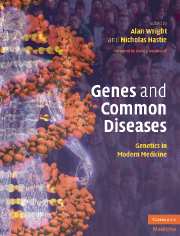Book contents
- Frontmatter
- Contents
- List of Contributors
- Foreword
- Section 1 Introductory Principles
- Section 2 Common Medical Disorders
- 13 Developmental disorders
- 14 Genes, environment and cancer
- 15 The polygenic basis of breast cancer
- 16 TP53: A master gene in normal and tumor suppression
- 17 Genetics of colorectal cancer
- 18 Genetics of autoimmune disease
- 19 Susceptibility to infectious diseases
- 20 Inflammatory bowel diseases
- 21 Genetic anemias
- 22 Genetics of chronic disease: obesity
- 23 Type 2 diabetes mellitus
- 24 Genetics of coronary heart disease
- 25 Genetics of hypertension
- 26 Obstructive pulmonary disease
- 27 Skeletal disorders
- 28 The genetics of common skin diseases
- 29 Molecular genetics of Alzheimer's disease and other adult-onset dementias
- 30 Major psychiatric disorders in adult life
- 31 Speech and language disorders
- 32 Common forms of visual handicap
- 33 Genetic and environmental influences on hearing impairment
- 34 Pharmacogenomics: clinical applications
- Index
- References
14 - Genes, environment and cancer
Published online by Cambridge University Press: 17 August 2009
- Frontmatter
- Contents
- List of Contributors
- Foreword
- Section 1 Introductory Principles
- Section 2 Common Medical Disorders
- 13 Developmental disorders
- 14 Genes, environment and cancer
- 15 The polygenic basis of breast cancer
- 16 TP53: A master gene in normal and tumor suppression
- 17 Genetics of colorectal cancer
- 18 Genetics of autoimmune disease
- 19 Susceptibility to infectious diseases
- 20 Inflammatory bowel diseases
- 21 Genetic anemias
- 22 Genetics of chronic disease: obesity
- 23 Type 2 diabetes mellitus
- 24 Genetics of coronary heart disease
- 25 Genetics of hypertension
- 26 Obstructive pulmonary disease
- 27 Skeletal disorders
- 28 The genetics of common skin diseases
- 29 Molecular genetics of Alzheimer's disease and other adult-onset dementias
- 30 Major psychiatric disorders in adult life
- 31 Speech and language disorders
- 32 Common forms of visual handicap
- 33 Genetic and environmental influences on hearing impairment
- 34 Pharmacogenomics: clinical applications
- Index
- References
Summary
Introduction
Epidemiological studies have shown that environmental exposures influence a person's risk of disease. For instance, migration studies show that a person's risk of cancer changes as he/she moves across environments; such changes must be due to changing exposures, as the host genome remains essentially constant (Haenszel, 1982). Studies comparing the lifestyle of persons with cancer (cases) and those without cancer (controls) have identified a number of consistent differences, assumed to be risk factors for that cancer, although the critical aspect of exposure is usually unknown or poorly measured. For instance, case-control studies show that persons with higher levels of smoking are more at risk of lung cancer, or those reporting diets higher in animal fat have a higher risk of bowel cancer but the critical combination and timing of mutagens, carcinogens, tumor promoters etc. is unknown. Instead, exposures are reported as number of packs of cigarettes per year or estimated average number of calories from fat. Chapter 11 discusses some of these issues in greater depth including the definition of the term “environment”.
Genetic studies have shown that, for some persons, susceptibility is determined at least in part by genes (Eeles et al., 2004). Family history studies indicate that for most common cancers, close relatives of cases have a risk of that same cancer which is between twice and four times that of the general population (Goldgar et al., 1994; Hemminki et al., 2004).
- Type
- Chapter
- Information
- Genes and Common DiseasesGenetics in Modern Medicine, pp. 213 - 223Publisher: Cambridge University PressPrint publication year: 2007



